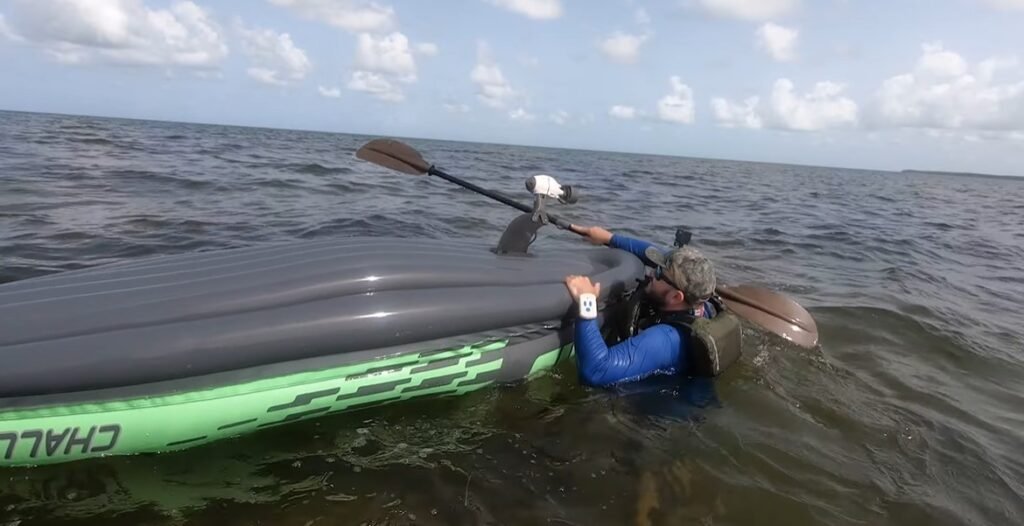Ever felt the rush of adrenaline as you paddle your way through challenging water currents? It’s quite an adventure, isn’t it? But how about doing all that in an inflatable kayak?
The question on every adventurer’s mind is, ‘Do inflatable kayaks tip over easily?’ The answer is no. Inflatable kayaks are designed to be stable and durable. They can withstand rough waters without tipping over.
Are you curious about why this is the case? Or maybe you’re wondering how these lightweight water vessels manage to stay afloat even under tough conditions. We have some fascinating insights lined up for you. Read on and let’s dive right into the world of inflatable kayaks!

What Factors Contribute to Kayak Stability?
The stability of a kayak is predominantly influenced by four key aspects: the design and shape, the width, the weight capacity, and your personal skill level.
These elements intertwine to determine how well you can balance on water using this type of vessel. Let’s dig deeper into these factors for a clearer understanding.
The Design and Shape
The kayak’s design and shape play a major role in its overall stability. Generally, kayaks with flat bottoms offer high initial stability making them excellent for calm waters.
On the other hand, those with rounded or V-shaped hulls have higher secondary stability which means they are more suited for rough waters as they can better resist capsizing.
The Width
Width is another crucial factor that affects kayak stability. Broadly speaking, wider kayaks tend to be more stable than their narrower counterparts because they distribute weight over a larger surface area thus increasing buoyancy.
However, it’s important to note that while wide kayaks enhance stability, they may compromise speed due to increased drag.
Weight Capacity
A kayak’s weight capacity significantly impacts its steadiness on water too. If overloaded beyond its recommended limit, even the most stable kayak will become difficult to control leading potentially dangerous situations like capsizing.
Therefore always ensure your total load (including yourself) does not exceed your vessel’s specified maximum weight limit.
Skill Level
Lastly but importantly your personal skill level greatly determines how stable you feel on a kayak regardless of its design or size specifications.
As one gains experience in paddling techniques and learns how to lean into turns without upsetting their balance, what once felt unstable might start feeling perfectly steady.
Are Inflatable Kayaks More Prone to Tipping Over?
Contrary to popular belief, inflatable kayaks are not more prone to tipping over compared to their hard-shell counterparts. The stability of a kayak, be it inflatable or hard-shelled, largely depends on its design and the skill level of the user.
The Role of Design
Let’s dig deeper into how design influences stability. Inflatable kayaks have wider hulls which give them excellent primary stability (stability when stationary or moving in a straight line). This makes them less likely to tip over under calm conditions.
User Skill Level
The following aspects may help you understand why user skill plays a significant role. A beginner might find an inflatable kayak easier due to its high initial stability, but experienced paddlers can handle both types efficiently without tipping over. Understanding your ability and adjusting your technique accordingly is key.
Kayak Usage
Furthermore, where you plan on using your kayak also affects its likelihood of tipping over. For example, inflatable kayaks are perfect for leisurely river trips but could struggle with rough sea waves.
How Does the Design of an Inflatable Kayak Affect its Stability?

The design of an inflatable kayak plays a significant role in determining its stability. Here’s how: The width, length, hull shape and construction material all contribute to the kayak’s balance on water.
A wider structure offers more surface area contact with water, adding stability. Similarly, a longer kayak cuts smoothly through water currents ensuring steady movement.
Now that we have established the premise, let us dig deeper into each aspect.
The Width Factor
A broader inflatable kayak provides enhanced balance as it increases the surface area in contact with water. However, this might compromise speed due to higher drag resistance but ensures greater steadiness especially for beginners or when paddling on rough waters.
Role of Length
Longer kayaks are designed to offer better tracking (the ability to move straight) which indirectly contributes to stability. They cut through waves and maintain direction even under strong currents thus providing steady movement.
Hull Shape and Its Impact
The hull shape significantly influences the buoyancy and overall performance of an inflatable kayak.
Flat-bottomed hulls are known for their excellent primary stability – they remain stable on calm waters making them suitable for beginners or leisure paddlers.
Rounded or V-shaped hulls provide good secondary stability – they perform well in choppy conditions by staying balanced when tilted sideways.
Construction Material Matters
High-quality materials ensure durability while also contributing to better control over the vessel’s movements thereby enhancing its stability.
Most inflatable kayaks use PVC, Nitrylon or Hypalon owing to their high strength-to-weight ratios which facilitates maneuverability without compromising sturdiness.
Practical Tips for Preventing Your Inflatable Kayak from Tipping Over
Maintaining balance in an inflatable kayak is crucial to prevent any unexpected capsizes. Here are some practical tips and techniques that will help you keep your boat steady and upright, enhancing your overall kayaking experience.
Understand the Basics of Weight Distribution
Balance plays a pivotal role in keeping your inflatable kayak stable. An unevenly distributed weight can make your kayak more prone to tipping over.
Therefore, ensure that all gear and equipment are evenly spread out in the kayak. If you’re kayaking with a partner, make sure both of you balance each other’s weight effectively.
Maintain Low Center of Gravity
Keeping a low center of gravity is another key strategy to avoid tipping over. This means staying seated as much as possible during your trip. Standing up or moving around too often can destabilize the boat easily.
Select Calm Waters
For beginners, it’s advisable to start kayaking on calm waters before venturing into rougher seas or rivers with strong currents. This gives one time to learn how the kayak responds under different circumstances while minimizing the risk of capsize.
Proper Paddling Techniques
Developing good paddling skills helps maintain stability in water bodies with waves or wind that may cause instability.
Practice different strokes such as sweep stroke for turning and forward stroke for propulsion until they become second nature.
Let’s dig deeper into these aspects which might assist you further:
- Paddle at Right Angles: Always try to paddle perpendicular to the waves; this reduces chances of flipping over.
- Avoid Leaning: Do not lean away from waves hitting your side; leaning towards them increases stability.
- Use of Skeg: A skeg, a removable fin-like component, helps in maintaining the kayak’s direction and reduces chances of tipping over.
Comparing the Stability of Inflatable and Hardshell Kayaks
When it comes to kayaking, stability is a crucial factor that can significantly impact your experience on the water.
While both inflatable and hardshell kayaks have their unique merits, understanding how they compare in terms of stability provides valuable insight for potential buyers.
Stability of Inflatable Kayaks
Inflatable kayaks are often lauded for their impressive stability. These types of kayaks feature a broad base which contributes to an increased level of balance, making them ideal for beginners or those who prefer calm waters.
Despite their lightweight nature, inflatable kayaks are highly resilient against capsizing thanks to their buoyant design. The air-filled chambers not only provide excellent flotation but also absorb impacts from waves effectively – enhancing the overall stability.
Stability of Hardshell Kayak
On the other hand, hardshell kayaks offer dependable stability under demanding conditions. They are typically designed with a narrower hull – promoting speed and maneuverability over pure balance.
Hard shells excel in choppy waters or strong currents where durability and control become paramount. Their rigid structure enables them to slice through waves smoothly without losing direction or tipping over easily.
Determining Factors for Kayak Stability
Let’s dig deeper into key factors influencing kayak stability:
Hull Design
A wider hull offers greater primary (initial) stability while narrower designs promote secondary (on-edge) stability.
Kayak Length
Longer kayaks tend to be more stable than shorter ones as they cover a larger surface area on the water.
Paddler Skill Level
Experienced paddlers may find better balance in hardshells due to advanced techniques whereas novices might favor inflatables’ forgiving nature.
FAQs
Are inflatable kayaks prone to capsizing?
Inflatable kayaks are generally very stable due to their wide base and can handle choppy waters well. Therefore, they do not tip over easily unless under extreme conditions.
Can wind cause an inflatable kayak to flip over?
Wind alone typically will not cause an inflatable kayak to capsize. However, strong gusts combined with rough water conditions might increase the risk, but it’s still relatively low.
How does the design of an inflatable kayak contribute to its stability?
The broad and flat bottom design of most inflatable kayaks makes them highly stable on water. This structure lowers their center of gravity which reduces the chances of tipping over significantly.
Is there a high risk of tipping in turbulent water while using an inflatable kayak?
While no boat is completely immune to capsizing in turbulent waters, inflatable kayaks are designed for stability. Hence, even in rougher waters, they maintain decent stability and do not tip over easily.
